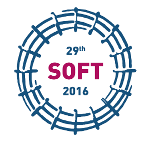Speaker
Toshiya Nakata
(Division of Industrial Innovation Sciences)
Description
The small punch (SP) test method is a one of the small specimen test techniques (SSTT). This method has several advantages: it requires only a small specimen, its test method is simple, and it is able to evaluate various mechanical properties. For these reasons, the SP method is commonly used in post-irradiation testing (PIE) of nuclear materials and as a damage evaluation technique for actual structural materials. However, because of the intricate deformation behavior of the specimen, stress and strain cannot be easily calculated; thus, it is difficult to make a direct comparison with standard test results. In this study, we attempted to estimate tensile properties by simulating SP test results, using Finite Element Analysis (FEA). By adjusting the material property parameters defined by the Ramberg-Osgood law in the FEA, the load-displacement curve of the SP test results were matched with that of the FEA simulation results. The actual stress-strain curves were reproduced using the obtained Ramberg-Osgood law, and it used to estimate the tensile properties up to the homogenous deformation region. This method was applied to an SP specimen collected from the local region of reduced activation ferrite/martenstic steel F82H welding material, and it was used to evaluate the tensile properties of the welding base material, the weld metal, and the heat-affected zone.
Co-authors
Hiroyasu Tanigawa
(Research Rokkasho Fusion Institue, Sector of Fusion Research and Development, Japan Atomic Energy Agency, Rokkasho, Japan)
Naoya Tada
(Division of Industrial Innovation Sciences, Graduate School of Natural Science & Technology, Okayama University, Okayama, Japan)
Shin-ichi Komazaki
(Division of Mechanical Engineering, Graduate School of Science and Engineering, Kagoshima University, Kagoshima, Japan)
Taichiro Kato
(Research Rokkasho Fusion Institue, Sector of Fusion Research and Development, Japan Atomic Energy Agency, Rokkasho, Japan)
Takeshi Uemori
(Division of Industrial Innovation Sciences, Graduate School of Natural Science & Technology, Okayama University, Okayama, Japan)
Toshiya Nakata
(Division of Industrial Innovation Sciences, Graduate School of Natural Science & Technology, Okayama University, Okayama, Japan)

